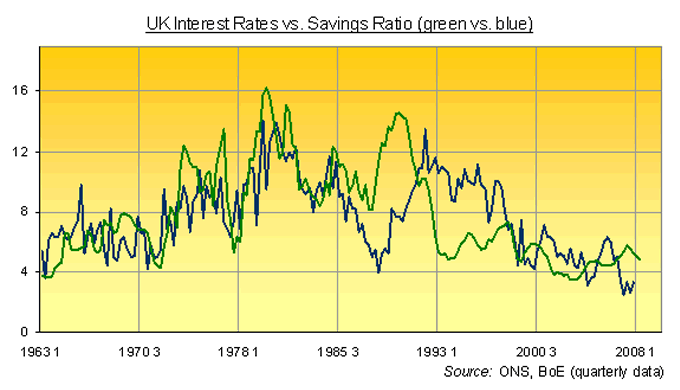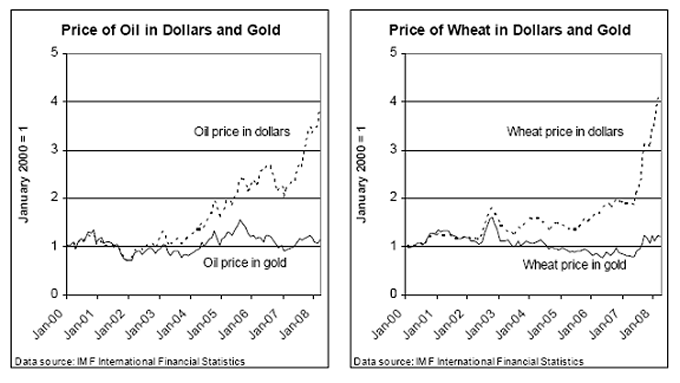UK Inflation Heading Back to 2%- What's Mervyn King Smoking?
Economics / Inflation May 21, 2008 - 05:14 PM GMTBy: Adrian_Ash
 "...The fiat-money experiment – along with the financial life-forms and hallucinations it spawned – has broken out of the lab and onto the street..."
"...The fiat-money experiment – along with the financial life-forms and hallucinations it spawned – has broken out of the lab and onto the street..."
WHEN ALBERT HOFMANN – the Swiss chemist who discovered LSD – passed away at the start of this month, newspaper editors the world over reported it as the death of the man "who experienced the first ever bad trip."
But from what...ummm...friends tell me, however, Hofmann's trip seems no worse than most others.
"Beginning dizziness," he wrote in his lab journal for 19 April 1943 . Looking to find a stimulant for the circulatory and respiratory systems, he'd just concocted – and taken – a big dose of lysergic acid diethylamide-25.
"Feeling of anxiety," he added. "Difficulty in concentration. Visual disturbances. Desire to laugh."
Then, underneath, he scrawled the words "most severe crisis".
Hofmann fled the lab on his bicycle, which appeared to stay stationary even as it wheeled him back home. There his neighbor – who brought him a glass of milk to calm him down – appeared as a witch in a colored mask. He felt possessed by demons. The furniture in his bedroom began to menace him.
Which is all pretty run of the mill stuff if you tinker with psychotropics.
But such "fantastic images" don't always ease into the sensations of "good fortune and gratitude" Hofmann enjoyed later that day. Hallucinations can still cause the "most severe crisis" – even without some fool laying Witches Hat by the Incredible String Band on the turntable.
"Inflation will return to the 2% target," claimed Mervyn King, head of the Bank of England last week. "Growth will eventually recover to a sustainable rate."
No tripping out there, perhaps. Just like Albert Hofmann's wobbly bike-ride six decades ago, the credit cycle will get us all home in due course, ready to turn once again from boom to bubble to bust.
But what was the Governor smoking when he claimed that "in these [current] circumstances, the household saving rate is likely to rise"...?

The Bank of England has been cutting UK interest rates since September. Its latest Inflation Report says it will continue to cut interest rates "in line with [bond] market expectations," too.
And UK households have grown their savings only once when interest rates fell in the last four-and-half decades. That brief period lasted for two years at the start of the 1990s.
Both before and since – and most markedly during the previous post-war recessions (of 1974 and 1981) – people have tweaked their savings almost precisely in line with changes to the rate of interest, as set by the Bank of England itself.
"This is part of a rebalancing of the UK economy, away from spending and importing, towards saving and exporting," claimed Mervyn King to reporters last week, pointing at the surge in household savings swirling above his head before asking if anyone wanted to split a Juicy Fruit chewing gum.
The sky's turned all purple in Washington too if US policy-makers think the credit crunch will somehow boost household savings. Consumers aged 45 and above are in fact raiding retirement accounts, reports the American Association of Retired Persons (AARP) – "a horrific scenario," according to Tom Nelson, the CEO.
"People are feeling this pinch in the short term...but the long-term consequences that are facing these individuals – and our economy – for years, if not decades, are frightening."
One in four middle-aged workers surveyed by the AARP says they're delaying retirement because of the crunch. The same proportion is withdrawing funds from pension and other savings accounts. The youngest baby-boomers are also failing to pay utility bills, reports MarketWatch – and "even cutting back on medications."
Well, they're cutting back on reported medications at least. Who can say what's being cooked up at home with the kids' old chemistry sets, dusted down from the attic?
Put another way, "who had heard of collateralized debt obligations just 10 years ago?" as Niall Ferguson, history professor at Harvard, asked in a speech opening New York's Museum of Finance in January this year.
"Collateralized loan obligations? Credit derivatives? These forms of financial instrument are of very recent origin. So are the hedge funds; so are the private equity partnerships; so are the sovereign wealth funds; and so are those wonderfully named entities, the conduits..."
Ferguson then flashed up a series of charts "to illustrate the speed with which these phenomena have proliferated." First, mortgage-backed securities, starting in 1980 – "when scarcely any such thing existed" – and totalling $3.5 trillion-worth today. Then he cited "the whole range" of other newly-born asset-backed instruments – automobile loans, equipment loans, student loans, credit card-backed debt derivatives...
"Over the counter derivatives outstanding?" the professor asked. "Well, if you'd asked someone to name that figure in 1987 it would have been a very small number indeed. Today we're talking about $450 trillion..."
Ferguson 's theme bears repeating; he likens the huge growth in complex financial products to an evolutionary spurt. Whereas here at BullionVault , we see it more as a bio-chemical experiment gone wrong. Now the primeval gunk is oozing over the edge of the petri dish...leaking out under the laboratory door...and the hare-brained PhDs mixing up the medicine are too spaced by half to even guess at what they've created.
"This is the kind of explosion of lifeforms that we also see in the natural world," Ferguson went on, "and one is bound to ask what caused it. Well, what causes it in the natural world is usually some fundamental change in the climate, in the environment. And it seems to me that what happened from around 1980 was that the financial climate became unusually benign...Financial institutions took advantage of a warm climate, so to speak, to proliferate, to multiply and to speciate."
Taking hedge funds as an example, Ferguson notes that in 1990, those financial life-forms known as "hedge funds" numbered around 600 (also including funds of funds). Now they've reproduced and multiplied up towards 10,000.
"As a form, the hedge fund dates back to the 1940s. But this population explosion is of very recent origin."
The raw numbers also hide a "regular, annual dying out"; there's chronic survivorship bias in the data. In 2006, for example, 717 hedge funds were culled; the 2007 figure should be even larger. And here, believes Ferguson , we see survival of the fittest in action. If he's wrong, perhaps it's just the contingency of life itself, allowing the standard proportion of idiots to thrive and market their "top decile" performance to a new generation of unwitting investors.
The survivors have been getting larger too, with the top five hedge funds running assets of around $100 billion. All told, in fact, hedge funds accounts for between one-third and one-half of all trading on the US and UK equity markets. Yet they barely showed up in newspaper and TV reports before 1997, when the death of Long-Term Capital caused a blip in their break-neck rate of evolution.
Where Ferguson 's analogy breaks down is in his admission of "intelligent design". Whether or not you hold with this evolutionary sop to religion, casting central bankers in the role of "minor gods" gives them more power than they really hold, even if it's less power than they believe they can wield.
Niall Ferguson accepts this. " Without occasional bouts of what Joseph Schumpeter, the Harvard economist, termed creative destruction," he wrote in the Financial Times last December, "the evolutionary process will be thwarted. Japan's experience in the 1990s stands as a warning to legislators and regulators that an entire banking sector can become a kind of economic dead hand if institutions are propped up despite underperformance."
But the bad trip of Japanese deflation – now running for almost two decades in equities and real estate prices – failed to scare off the amateur chemists at the Bank of England, Federal Reserve and European Central Bank, however. Tinkering with near-zero and sub-zero real rates of interest at the start of this decade, they helped create two impossible hallucinations.
First, that the resulting credit expansion would fail to show up in consumer inflation. Second, that the credit cycle could just keep running on without ever needing to turn, just like the wheels on Albert Hofmann's bike.
"A lot of reporters ask me these days whether we're in the midst of a commodity bubble," said Dr. Benn Steil, senior fellow at the Council on Foreign Relations, at the Hard Assets Conference in New York last week.
"In fact, I'm going to Washington to give a Senate testimony . [Because] my perspective is that the more interesting, and indeed more important, question to ask is whether we're at the end of what I would call a 'fiat currency bubble'."

Like Professor Ferguson, Dr. Steil looks back "to the early 1980s" to identify the start of whatever it is we're now watching mutate, if not die.
Under Paul Volker at the Federal Reserve, "inflation, and at least equally importantly inflation expectations, were driven out of the system through a pretty ruthless policy of very tight money, high interest rates. Very tight money."
What followed was "the golden age of the fiat Dollar" says Steil, reminding us that credit expansion was unshackled from Gold in 1971, when Richard Nixon stopped redeeming the US currency for bullion altogether. It took tight money – "very tight money" – to bring the resulting inflation of the 1970s under control.
The fiat money experiment then hit its straps with the "explosion" of financial life-forms witnessed from 1980 right up to last summer. Indeed, it all ran just fine until around 2002, when the cost of key raw materials – notably wheat and oil, as in Steil's charts above – began to shoot higher in terms of Dollars and other government currencies.
Measured against Gold Prices , however, they've barely budged. "That shouldn't surprise people," says Steil, "because as we go back to the era of the gold standard from about 1880 until the outbreak of the first World War in 1914, prices around the world in countries that were on the gold standard were also remarkable flat.
"The figure looked just like this. So Gold is behaving as it has historically."
Now the fiat-money experiment – as well as the financial life-forms and hallucinations it spawned – has run out of control. Thank goodness we have Dr. Ben Bernanke and his old colleague Mervyn King to talk Wall Street and the City back down from their moment of "worst crisis ever".
By Adrian Ash
BullionVault.com
Gold price chart, no delay | Free Report: 5 Myths of the Gold Market
City correspondent for The Daily Reckoning in London and a regular contributor to MoneyWeek magazine, Adrian Ash is the editor of Gold News and head of research at www.BullionVault.com , giving you direct access to investment gold, vaulted in Zurich , on $3 spreads and 0.8% dealing fees.
(c) BullionVault 2008
Please Note: This article is to inform your thinking, not lead it. Only you can decide the best place for your money, and any decision you make will put your money at risk. Information or data included here may have already been overtaken by events – and must be verified elsewhere – should you choose to act on it.
Adrian Ash Archive |
© 2005-2022 http://www.MarketOracle.co.uk - The Market Oracle is a FREE Daily Financial Markets Analysis & Forecasting online publication.



